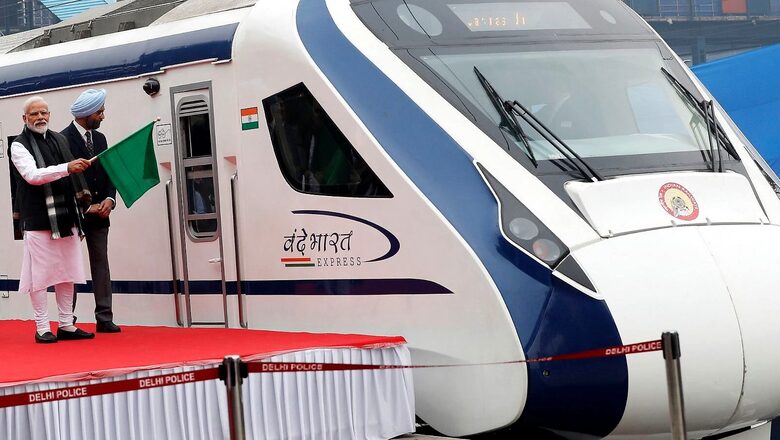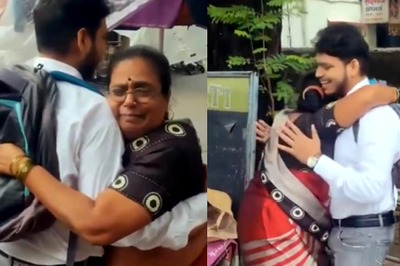
views
A product of the central government’s ‘Make in India’ initiative, the Vande Bharat Express train was introduced with an aim to provide a completely new travel experience to passengers of the Indian Railways with speed, safety and service as its hallmarks. Prime Minister Narendra Modi flagged off the sixth Vande Bharat train to Bilaspur from the Nagpur railway station on Sunday.
Here is a look at the journey of these trains so far:
What is a Vande Bharat train and why was it introduced?
The Vande Bharat train is the next major leap for the Indian Railways in terms of speed and convenience. The railways launched India’s first indigenous semi-high speed train, Vande Bharat Express in February 2019 between New Delhi and Varanasi.
It is equipped with world-class passenger amenities and can achieve high speeds due to faster acceleration and deceleration. It reduces journey time by 25 percent to 45 percent.
The first Vande Bharat train reduced the travel time between New Delhi and Varanasi by nearly 50 percent than the fastest train that connected the two cities. This train was introduced to upgrade maintenance technologies and methodologies as well as achieve improvement in productivity and performance of all railway assets and manpower in reliability, availability, utilisation and efficiency.
The Vande Bharat Express can run up to a maximum speed of 180 kmph and has travel classes much like the Shatabdi but with better facilities. It aims to provide a new travel experience to passengers with respect to speed, safety and service.
In-house design and manufacture
The Integral Coach Factory (ICF) in Chennai, a railways production unit, has been the force behind a completely in-house design and manufacture, computer modelling and working with a large number of suppliers for system integration in just 18 months. It costs about Rs 120 crore to make one Vande Bharat train.
These trains are a testimony to the capability of Indian engineers and a culmination of the ‘Make in India’ initiative. It is a big milestone towards realising the ‘Atmanirbhar Bharat’ vision of the prime minister.
Earlier this year, a new version of the train, Vande Bharat 2.0, was launched by the railways. The train flagged off in September from Gandhinagar to Mumbai was the Vande Bharat 2.0, which is equipped with a range of advanced features over its predecessor. It is able to attain a maximum speed of up to 180 kmph, and is lighter, weighing 392 tonnes instead of the earlier 430 tonnes.
The earlier version could reach up to 160 kmph. The Vande Bharat 2.0 has finer heat ventilation and air-conditioning control through higher efficiency compressor with ultra violet (UV) lamp for germ-free supply of air. There is a driver-guard communication with a voice recording facility.
Also, there are changes of formation with a non-driving trailer coach in the middle for better acceleration and deceleration. The train has better ventilation for the traction motor for better reliability. It also has two signal exchange lights on the coaches for exchange of signals with the wayside stations.
The Vande Bharat 2.0 trains have the KAVACH (Train Collision Avoidance System) for enhanced safety in operations. They also have improved security with four emergency windows added in every coach.
There are four platform-side cameras, including rearview cameras outside the coach. The new coaches have level II safety integration certification for better train control. These trains also have better fire safety measures with aerosol-based detection and suppression systems in all electrical cubicles and toilets.
The newer version of the train also has superior flood proofing for underslung electrical equipment to withstand floods up to 650 mm as compared to 400 mm earlier. It has four emergency lights in every coach in case of electric failure. Further, these trains have bio-vacuum toilets with touch-free amenities and WiFi content on demand.
What are the routes?
So far, there are five Vande Bharat Express trains on the following routes:
- New Delhi-Shri Vaishno Devi Mata, Katra
- New Delhi-Varanasi
- Gandhinagar capital-Ahmedabad-Mumbai Central
- Amb Andaura-New Delhi
- Mysuru-Puratchi Thalaivar Dr MGR Chennai Central
The Mysuru-Chennai Central Vande Bharat is the first such train in South India.
What’s next?
In the Union Budget 2022-23, finance minister Nirmala Sitharaman announced that 400 new-generation Vande Bharat trains with better energy efficiency and passenger-riding experience will be developed and manufactured during the next three years.
In his address to the nation on August 15, 2021, from the ramparts of Red Fort, Prime Minister Modi announced that during the 75 weeks of the ‘Azaadi ka Amrit Mahotsav’, 75 Vande Bharat trains will connect every corner of the country.
Read all the Latest India News here




















Comments
0 comment